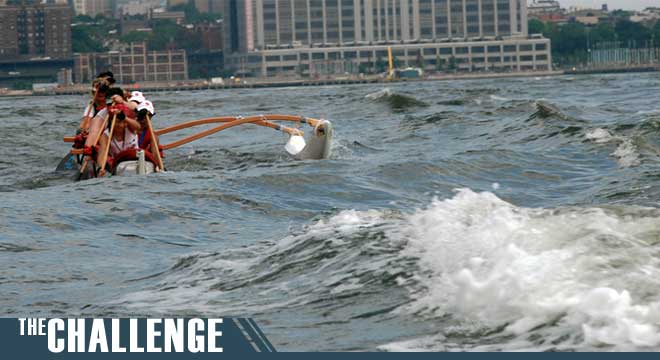The Challenge: Tides and Currents

“We were seeing this morning a women’s crew paddling up current and getting swept back. They were just stuck in the middle of the river…fighting as hard as they can.” – Luke Evslin . Team Kamanu
The Hawaiian Airlines Liberty Challenge is perhaps best known for its exceptionally strong and shifting currents. Conditions change dramatically from complete calm to a 4-knot current within an hour. The reasoning for this is a combination of natural and man-made conditions that are unique to this area. The Race Course for the Liberty Challenge will take the crews into the Hudson River, East River and New York Harbor.
The lower section of the Hudson River is a 1-mile wide navigable river that drains almost all of the eastern half of the state of New York. While it is a fresh water river, the tide effect makes this portion in New York City brackish. The effect of high and low tides are interesting on the Hudson River. As a river, there is a constant southerly flow of fresh water heading to New York Harbor and the Atlantic Ocean. Due to this flow, there is typically a delay in the high tide current as it must first counteract the flow of the river. It creates a unique swirling and choppy effect in the water as the waters shift from a southerly to a northerly direction as we reach high tide. Low tide, however, has dramatic strength as the ebbing tide couples with the Hudson River’s constant southerly flow to create very strong currents heading into New York Harbor. If you are paddling in that direction, it is not uncommon to hit up to 7-8 knots (8-9mph) in an OC6. However, paddling against the current can have your crew going no more than 2 knots (2mph).
The East River is actually not a river at all. It is a tidal strait that regulates the flow between Long Island Sound and Upper New York Bay (aka. New York Harbor). It shifts directions four times a day and, because it is so narrow and connects to large bodies of water on each end, the currents are extremely swift. Boating accidents and shipwrecks have occurred regularly in the East River for centuries due to its complicated waters. Saying the currents can be strong is an understatement. I have steered strong crews through the narrowest sections of the East River with the current clocking in at over 12 knots (14mph) in an OC6. Going against the current can be pure hell. There have been times where I have had a strong crew paddling as hard as they can and I will look up at the adjacent walkway and see people walking faster than us.
New York Harbor has its own set of parameters. Primarily, it is a large mixing pot. During low tide, water is rushing out to the Verrazano Narrows in a generally southerly flow. Buttermilk Channel (located between Governors Island and Brooklyn) is particularly strong as the waters from the East River runs through this section. The islands in New York Harbor also creates a series of eddies in the harbor as the currents swirl around them. High tide is swift but in a more predictable manner with the water rushing into the Hudson and East Rivers.
So what can a steersperson do to harness or diminish the power of these currents? Within the rivers, if the current is in the direction of travel, it is best to stay as far out as possible to take advantage of the deeper dredged shipping channel. If a crew is paddling against the current, the best thing a steersperson can do is stay as close to shore as the rules permit and reading the water to locate eddies created by pier heads that deflect the current to give the paddlers a little bit of a break and maybe surge ahead of someone else caught in the current.
The tides and currents act in such a way that is unique to the geography of the area and, as mentioned in my first article about the Staten Island Ferry, the Liberty Challenge start times are not designed to work with the tides unlike many of the other watersport races that take place in New York Harbor. Many first-time steerspeople are surprised by the strength of the current and what it does. It can be unnerving at times as it seems the waters are doing the exact opposite of what one would expect. In actuality, there is always a reason for what is happening. Understanding and respecting them is the key. Trying to work against them will get you and your crew hurt. In the end, however, there really is no better advice than to simply grit your teeth and just paddle.
The Challenge Series is written by New York Outrigger Head Coach Keith Tsang. His insights are drawn from over ten years of paddling and steering the New York and New Jersey waterways.
Category: Blog, Home, Homepage News, The Challenge







Learn how the currents of #NYC makes the @HawaiianAir #LibertyChallenge a challenge. http://t.co/Nf6THCFQEr
Check it out! RT @nyoliberty: Learn how the currents of #NYC makes the @HawaiianAir #LibertyChallenge a challenge. http://t.co/cqT3gveUzk